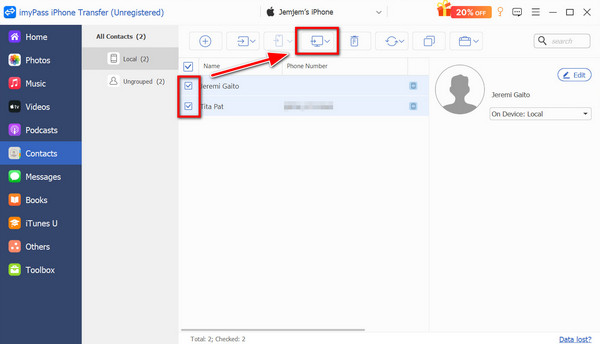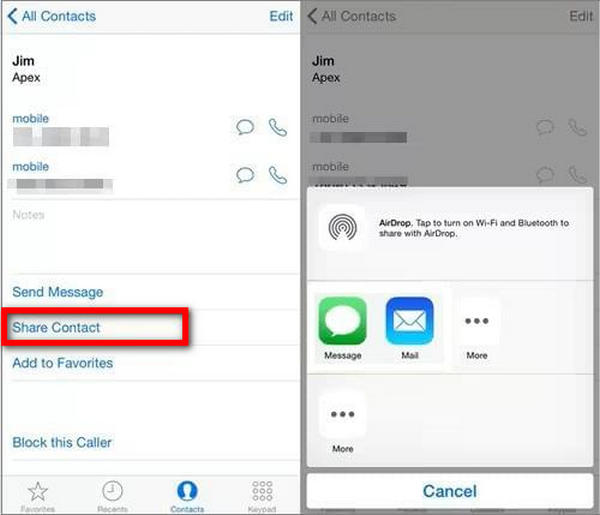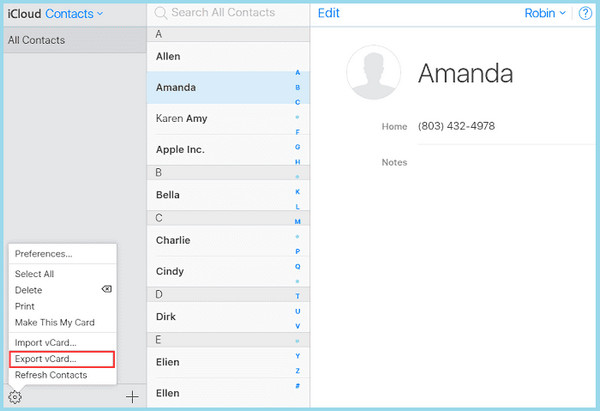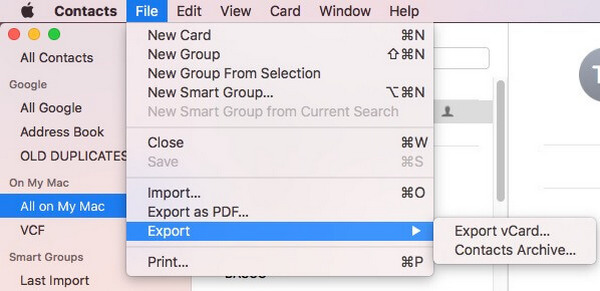Step-by-Step Guide to Export Contacts from iPhone In A Few Minutes
The ability to export contacts from an iPhone is essential for anyone who wants to back up data, switch to a new device, or share contacts in various formats. While iCloud and native apps offer built-in methods for handling this, many users also prefer third-party tools for greater flexibility and control. From saving vCards and sending them via AirDrop or email, to converting your contacts into CSV or Excel for spreadsheets, there are simple methods available.

In this article:
Part 1. How to Export Contacts from iPhone Easily
imyPass iPhone Transfer lets you export contacts from an iPhone without any hassle. It is more advanced than iTunes. It enables you to transfer, back up, and manage contacts in a few clicks. It offers quick transfers and excellent contact management on both Windows and Mac without any issues.

4,000,000+ Downloads
Move all or selected contacts from your iPhone to your computer in seconds.
Save your call history together with contacts for easy backup.
Edit, delete, or update contact information directly from your laptop.
Automatically detect and remove duplicate contacts to keep your phonebook organized.
Export contacts while creating new groups or sorting them for better accessibility.
Download and Install the Tool
Visit the official imyPass website, download imyPass iPhone Transfer for Windows or Mac, and install it.
Connect iPhone to Computer
After connecting your iPhone to the computer using the USB cable, open imyPass iPhone Transfer, and the device will be detected.

Choose Contacts to Export
Select the Contacts option, and the interface allows you to preview, edit, and arrange your contact list before exporting.

Export Contacts
Select your desired format (CSV or vCard) and click Export to Computer. The contacts will be stored on your computer almost instantly.

Part 2. How to Export to a File & Share via AirDrop/Email
The Contacts app on your iPhone allows you to export your contacts into a vCard file (VCF format), which you can easily share with others or transfer to another device. vCards serve as digital business cards and are compatible with Outlook, Gmail, and macOS Contacts.
To access your saved contacts, tap Contacts from your home screen.
Tap and hold on to a list, or select an individual contact that you want to export. This allows you to export details for either a single individual or an entire group.
Choose the Share Contact option from the menu. You will receive a vCard file, a standard format for exporting contact information.

Select the information you would like to include. This information can be phone numbers, email addresses, mailing addresses, and notes. Tap Done after your selection.
Select how you would like to share the file.
- For quick transfer, use AirDrop to send the vCard to a nearby device, such as a Mac, iPad, or iPhone.
- Another option is to email the vCard, allowing you to save a copy of the email for backup.
Pros
- Does not need third-party applications
- vCard files work with multiple email services and applications
Cons
- Contact exports of considerable size may not be instant
- May need a conversion into a CSV or an Excel document
Part 3. How to Use iCloud.com to Export to CSV
The optimal way to make your iPhone contacts accessible for applications like Excel and Google Sheets is to create a vCard file through iCloud and convert it to CSV format.
On your iPhone, navigate to Settings > [your name] > iCloud and turn on Contacts to sync.
On a computer, navigate to a web browser, go to iCloud.com, and sign in with your Apple ID credentials.
Click on Contacts from the iCloud home screen.
Select the contacts you wish to export. Use Shift or Command+A on a Mac to select all, or a combination of keys for multiple selections.
Hit the Share button, then select Export vCard. This will download a .vcf file containing the selected contacts to your computer.

Step 6. Use an online converter, such as AConvert, to convert the .vcf file to .csv format. Then, you can open the converted CSV file in either Excel or Google Sheets to see and organize your contacts in a spreadsheet.
Pros
- Exports multiple contacts simultaneously, making it useful for large lists.
- Functionality through a web browser means no software installation is required, making it easy to restore contacts from iCloud whenever needed.
Cons
- An internet connection and an Apple ID login are required.
- Converting contacts to CSV for use in a spreadsheet adds an extra unnecessary step.
Part 4. How to Export with Contacts/Address Book App on Mac
macOS offers an integrated option through the Contacts app and gives you a simple method to export your synced iCloud contacts. The app will automatically display any contacts you have saved on your iPhone and backed up to iCloud, as it is linked directly to your Apple ID. This way, you can save, share, or back up your entire contact list without the hassle of third-party applications or services.
From the Applications folder on your Mac or using Spotlight, open the Contacts app.
Please ensure you are logged in under the Apple ID associated with your iPhone; otherwise, your iCloud contacts will not be displayed.
You can highlight the contacts you wish to export, whether it is an individual or a whole group, or use Command+A to select all.
Follow the menu bar to click on File > Export > Export vCard. Save the .vcf file to your desktop or an easily accessible folder.

Share or convert the file as needed. If you would like to open the file in Excel or Google Sheets, you can keep a copy of the vCard file, email it to yourself, or airdrop it to yourself and then convert it to CSV using the instructions in Part 3.
Pros
- Fast and instant contact exports.
- You can manage and control what will be exported to the vCard.
Cons
- The only option is to save contacts as vCard files on your computer, which can also help you recover deleted contacts when needed.
- You cannot save the exported files in any format other than vCard.
Conclusion
Being able to export phone contacts from the iPhone ensures you never lose important information and can easily move data between devices. iCloud, AirDrop, the macOS Contacts app, and even tools like imyPass iPhone Transfer all work seamlessly to provide you with an easy solution. You can choose any method that fits you best to keep your contacts easily organized, stress-free, shareable, and backed up.
Hot Solutions
-
Recover Data
- Recover WhatsApp View Once Photo
- Recover Deleted TikTok Videos on Mobile
- Recover Deleted Facebook Photo
- Recover Viber Messages, Photos, etc.
- Recover Deleted Snapchat Photos
- 5 Best Contact Recovery Apps
- Recover Deleted Discord Messages
- AppGeeker iOS Data Recovery Review
- Recover Data from DFU Mode
- Cannot Restore iPhone Backup
-
Unlock iOS
-
iOS Tips
-
Password Tips

